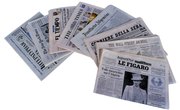Teachers in today's fast paced world of education are constantly seeking new and innovative ways to get their students actively involved in learning. When teaching business courses such as marketing, it is extremely important to assure that the assignments are project oriented and also teach the principles of promotion and distribution that are important within the business world. These are a few sample projects that would utilize the four P's of marketing: product, promotion, price and place.
Coupon Creation
In order to create a marketing project that is realistic and feasible, it is important to work with real businesses. Contact a local business and make an effort to work with the owner or the manager to create a coupon or a flyer that would be an effective marketing strategy for that particular business. Remember, your goal is to make more people aware of where the business is located, why this product is better than the other and how you can save the customer money. This project reinforces all of the P's of marketing, price, place, promotion and product. This coupon should be only reproducible with the permission and cooperation of the business owner.
Commercials
One of the best ways to market an idea or product is through a video. Many high school students today have access to video recorders and video editing software right at their high school. A great project to reinforce the marketing principals, product and promotion would be have the students create an original video in the form of a commercial for a product of their choice. By creating a commercial to promote a local band or a school event, students would be able to see the success of their promotional work.
Newspaper Advertisements
Newspaper advertisements are a great form of marketing. Working together with the journalism teacher or with the head of the school newspaper, students could see first hand the power of print. Students would learn the importance of newspaper advertising by working together to create an ad in their own school's newspaper. By contacting a local business and coming up with a slogan for the ad, students could see that by marketing a business to a particular age group through a high school newspaper, their results will be very specific, therefore reinforcing the principals of promotion and place.
Online Social Networking
With the Internet being one of the biggest channels of advertising, creating a page on a social networking site would be a great way to market a product or an idea. One specific marketing strategy could include building a student council campaign through the use of a social networking site. Students would learn that the amount of traffic their page receives will increase their likelihood of being heard. A student running for a class office could utilize their social networking site to increase their voters. Students who are not running for office would manage the other's campaigns. Utilizing a tool that many students already use on a daily basis will increase their interest in the project.
Taste Test
High school students love to eat. What better way to get others involved in a marketing project than to have the students set up a taste test. The students will be required to decide upon a food to market and then purchase the competitor's version of this food as well. Once the different foods have been removed from their original packaging, the taste testing begins. Have a taste test and let the students decide if his product truly is the best. After all of the eating is finished, students will poll their classmates to see if the students have been properly convinced to buy the product being promoted. This will teach the students that product and promotion are very key elements in marketing.
Related Articles
References
Writer Bio
Stephie Sweat holds a master’s degree in education as well as a bachelor’s degree in English and communication skills. Having primarily worked in education for the past several years, Sweat has also spent a large majority of her time writing both personally and professionally including articles written for eHow.











